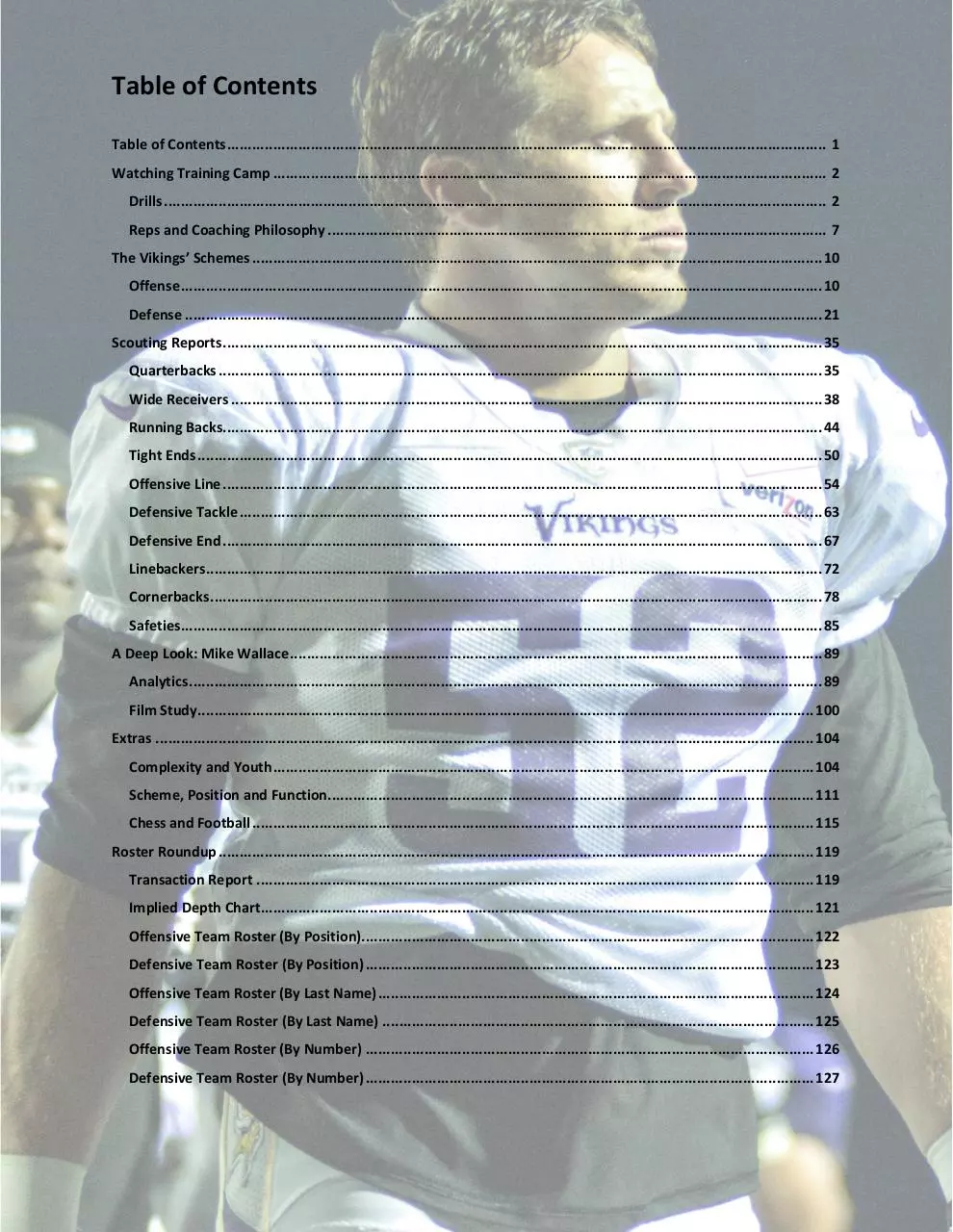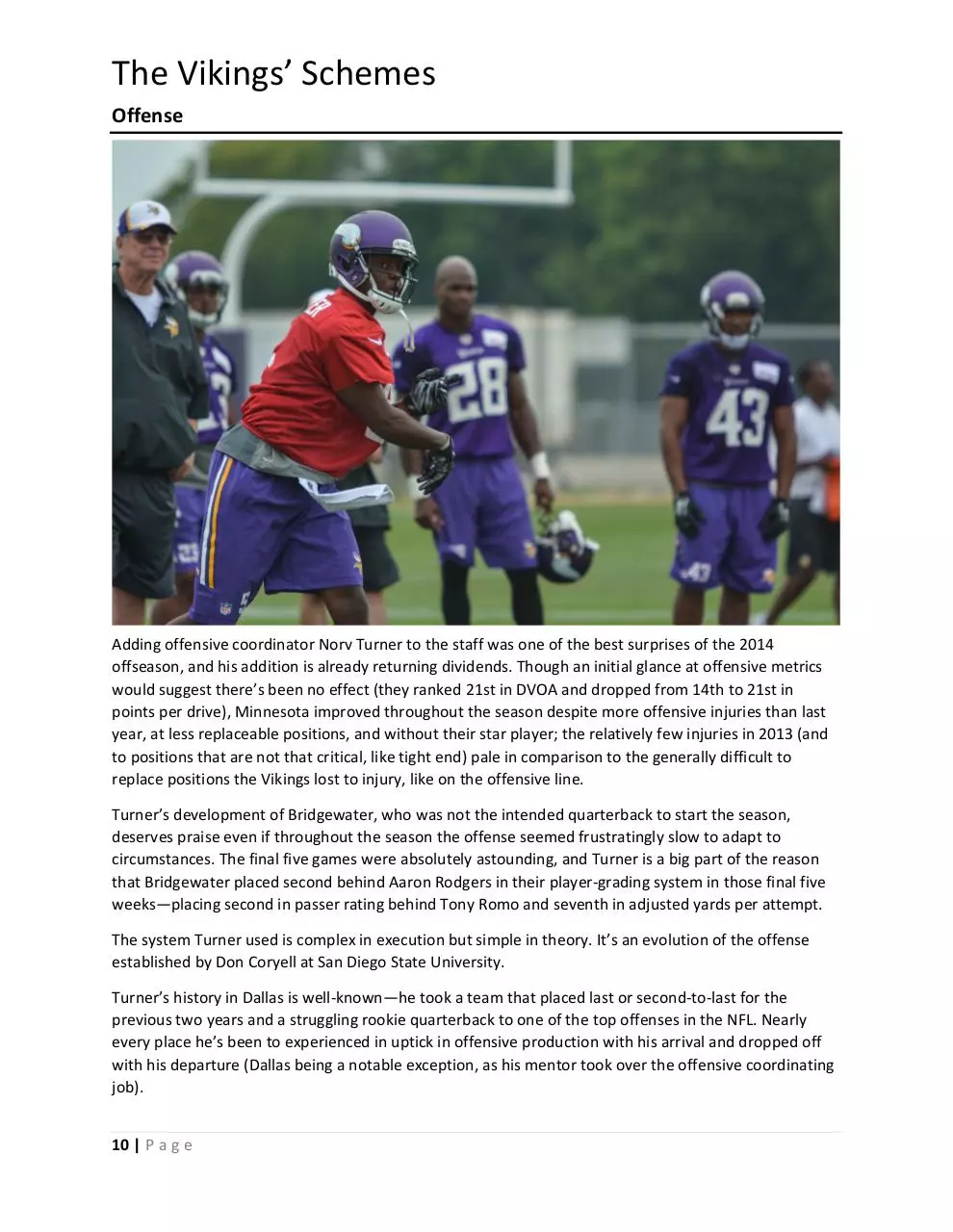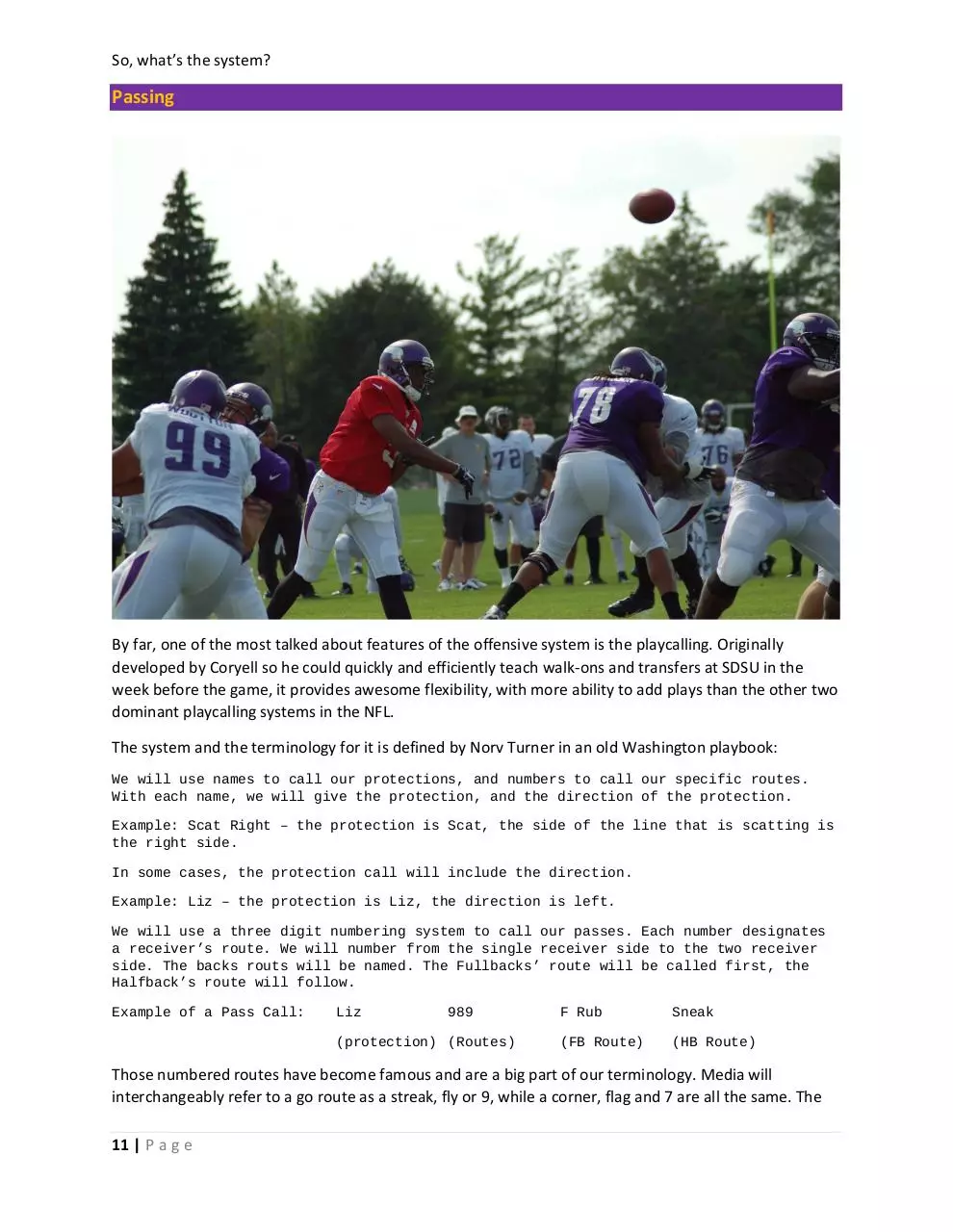2015 Minnesota Vikings Training Camp Guide (Sample) (PDF)
File information
This PDF 1.6 document has been generated by Adobe Acrobat Pro 11.0.9, and has been sent on pdf-archive.com on 22/07/2015 at 23:58, from IP address 50.188.x.x.
The current document download page has been viewed 608 times.
File size: 3.31 MB (10 pages).
Privacy: public file





File preview
Table of Contents
Table of Contents ............................................................................................................................................... 1
Watching Training Camp .................................................................................................................................... 2
Drills .............................................................................................................................................................. 2
Reps and Coaching Philosophy ....................................................................................................................... 7
The Vikings’ Schemes ........................................................................................................................................ 10
Offense ......................................................................................................................................................... 10
Defense ........................................................................................................................................................ 21
Scouting Reports ............................................................................................................................................... 35
Quarterbacks ................................................................................................................................................ 35
Wide Receivers ............................................................................................................................................. 38
Running Backs............................................................................................................................................... 44
Tight Ends ..................................................................................................................................................... 50
Offensive Line ............................................................................................................................................... 54
Defensive Tackle ........................................................................................................................................... 63
Defensive End ............................................................................................................................................... 67
Linebackers ................................................................................................................................................... 72
Cornerbacks .................................................................................................................................................. 78
Safeties......................................................................................................................................................... 85
A Deep Look: Mike Wallace ............................................................................................................................... 89
Analytics ....................................................................................................................................................... 89
Film Study................................................................................................................................................... 100
Extras ............................................................................................................................................................. 104
Complexity and Youth ................................................................................................................................. 104
Scheme, Position and Function.................................................................................................................... 111
Chess and Football ...................................................................................................................................... 115
Roster Roundup .............................................................................................................................................. 119
Transaction Report ..................................................................................................................................... 119
Implied Depth Chart.................................................................................................................................... 121
Offensive Team Roster (By Position)............................................................................................................ 122
Defensive Team Roster (By Position) ........................................................................................................... 123
Offensive Team Roster (By Last Name) ........................................................................................................ 124
Defensive Team Roster (By Last Name) ....................................................................................................... 125
Offensive Team Roster (By Number) ........................................................................................................... 126
Defensive Team Roster (By Number) ........................................................................................................... 127
1|Page
The Vikings’ Schemes
Offense
Adding offensive coordinator Norv Turner to the staff was one of the best surprises of the 2014
offseason, and his addition is already returning dividends. Though an initial glance at offensive metrics
would suggest there’s been no effect (they ranked 21st in DVOA and dropped from 14th to 21st in
points per drive), Minnesota improved throughout the season despite more offensive injuries than last
year, at less replaceable positions, and without their star player; the relatively few injuries in 2013 (and
to positions that are not that critical, like tight end) pale in comparison to the generally difficult to
replace positions the Vikings lost to injury, like on the offensive line.
Turner’s development of Bridgewater, who was not the intended quarterback to start the season,
deserves praise even if throughout the season the offense seemed frustratingly slow to adapt to
circumstances. The final five games were absolutely astounding, and Turner is a big part of the reason
that Bridgewater placed second behind Aaron Rodgers in their player-grading system in those final five
weeks—placing second in passer rating behind Tony Romo and seventh in adjusted yards per attempt.
The system Turner used is complex in execution but simple in theory. It’s an evolution of the offense
established by Don Coryell at San Diego State University.
Turner’s history in Dallas is well-known—he took a team that placed last or second-to-last for the
previous two years and a struggling rookie quarterback to one of the top offenses in the NFL. Nearly
every place he’s been to experienced in uptick in offensive production with his arrival and dropped off
with his departure (Dallas being a notable exception, as his mentor took over the offensive coordinating
job).
10 | P a g e
So, what’s the system?
Passing
By far, one of the most talked about features of the offensive system is the playcalling. Originally
developed by Coryell so he could quickly and efficiently teach walk-ons and transfers at SDSU in the
week before the game, it provides awesome flexibility, with more ability to add plays than the other two
dominant playcalling systems in the NFL.
The system and the terminology for it is defined by Norv Turner in an old Washington playbook:
We will use names to call our protections, and numbers to call our specific routes.
With each name, we will give the protection, and the direction of the protection.
Example: Scat Right – the protection is Scat, the side of the line that is scatting is
the right side.
In some cases, the protection call will include the direction.
Example: Liz – the protection is Liz, the direction is left.
We will use a three digit numbering system to call our passes. Each number designates
a receiver’s route. We will number from the single receiver side to the two receiver
side. The backs routs will be named. The Fullbacks’ route will be called first, the
Halfback’s route will follow.
Example of a Pass Call:
Liz
989
(protection) (Routes)
F Rub
Sneak
(FB Route)
(HB Route)
Those numbered routes have become famous and are a big part of our terminology. Media will
interchangeably refer to a go route as a streak, fly or 9, while a corner, flag and 7 are all the same. The
11 | P a g e
route numbers are also tagged, so “Bang 8” has a different angle than “Seam 8” despite both being “8”
(or post) routes. They all also have “action” tags for play action-passing.
A lot of resources will switch the 5 with the 3 and the 6 with the 4, and they may be right for the offense
they are describing, but above is the route tree Turner outlined in his playbooks. We’ll also often see
route trees where routes 3-8 all stem at the same spot, and that generally fits how many offenses work,
but in this case, those routes are tagged instead of the original numbers.
Those are just the outside receiver routes (some of which operate differently for the X receiver on the
line of scrimmage than for the Z receiver off the line of scrimmage). Here are the slot routes:
And those route numbers are different than the tight end route numbers.
12 | P a g e
It gets massively more complicated than that for every route, and each route has a few tags. Not only do
they each have tags (each route may have 4 or so—that’s 40 different routes!), they each have specific
instructions for certain coverages. Take a look at how Mike Martz constructed his route grid for the 0
route for receivers:
There’s no reason to include the full playbook, but you get the idea.
Generally speaking, as a pass coordinator, Norv Turner like late-developing routes and route
combinations. When compared to the rest of the NFL, Turner tends to have his receivers run more dig
13 | P a g e
Wide Receivers
The Vikings’ receiver corps hasn’t changed much in essence even with big turnover with their highestpaid receiver (from Greg Jennings to Mike Wallace) and a smart fifth-round pickup—it is still essentially
full of players defined by their potential more than their provable talent. It’s the fastest corps in the NFL
while also sporting young talent across the roster. The oldest receiver in the corps exists within
uncertainty as well, as he’s had some of the most exciting and most disappointing years in the league.
Mike Wallace
There’s a full scouting report of Mike Wallace later in the guide.
Acquired for a fifth-round pick (receivers picked in the fifth round this year include Stefon Diggs, J.J.
Nelson, Kenny Bell and Rashad Greene), the former Pittsburgh and Miami speedster is poised for a
career revival in Minnesota, but carries a lot of baggage with him as well.
Strengths: Clearly a speed demon about to hit his athletic prime, there are very few exciting home-run
hitters with the explosive ability of Mike Wallace. Wallace does like to slowplay his routes and
understands the natural extension of his speed are his ability to threaten underneath. He can shoulder
fake open corner and post routes, and tracks the ball well in the air. He has impressive contortion
abilities and can leap for the ball.
Weaknesses: Wallace’s speed doesn’t come with a full route tree, and he has limited usage because of
it. His ability to deceive is subpar, and he rounds out routes that aren’t comebacks or go routes. Known
for attitude issues in Pittsburgh as well as Miami, Wallace can be an enormous distraction (though has
always been known as a hard practice worker). He’s poor at winning contested catches and defensive
backs who stay with him wash him out of the play entirely. He can’t play physically (though in some part,
38 | P a g e
he’s made up for this with elusiveness) and his route depths are bad—miscommunication between him
and Tannehill are often because he’s in the wrong place. He has little sideline awareness when making
sideline catches. His acrobats when attempting to catch passes are often counterproductive.
Wallace is a one-note receiver. Sometimes, that’s great because it’s a really good note. Just don’t ask
him to do to much.
Charles Johnson
Johnson’s career path is exactly the kind of stuff NFL fans love to see. From a small-school and drafted in
the seventh round, Johnson bounced around on two practice squads and suffered an injury in the
process before landing on a team, and mostly as a flier. Johnson took advantage of his opportunity to
become a starter, and before long was called the best receiver on the roster by the offensive
coordinator—not a sign of desperation, but hope.
Strengths: Johnson is a fast, tall receiver with good leaping ability and a lot of promise. He’s improved
on his route running from Grand Valley State. He has good hands and the ability to make difficult
catches on the sideline. His ability to keep defensive backs guessing allows him to get open deep and
though his track speed hasn’t fully materialized into deep speed, it’s there and it shows up when he
accelerates mid-route. Johnson’s release off the line has improved since he took preseason snaps in
Green Bay two years ago, and he’s developed a fuller arsenal of moves to get off of jams. There were
concerns coming out of the draft that he may not have the right football character to succeed because
he switched schools so often. That really turns out not to be the case—he’s an incredibly dedicated
worker with high character; he had transferred schools to be with his sick father, who had survived four
heart attacks and has multiple types of cancer—giving up what he thought was an NFL career in the
process.
Weaknesses: Now that Justin Hunter has run into legal trouble, Johnson may be the worst starting
receiver in the NFL at contested catches. The former Grand Valley State receiver still needs to work on
exploding out of sharp cuts, but he still creates separation on routes with 90 degree breaks. Over time,
that tendency will decrease, so it’s better to fix it sooner than later. He is slow to decelerate on
comeback and curl routes, and that would be the perfect complement to his ability to get open on the
nine and post routes. Johnson is familiar with the offense but still needs to make sure he’s making the
right decisions against zone coverage and optioning routes correctly. Johnson is not a very physical
blocker. Though he has more release moves, he still needs to integrate them naturally into his running
so he doesn’t lose timing on routes—if he ends up starting opposite Wallace, he’ll see a lot of press
coverage on the line of scrimmage, so this will be critical.
Jarius Wright
Originally the third man left out of Arkansas’s famed class of receivers, Wright is the only one left
standing, ahead of injury-retirement and former Viking Greg Childs and former Carolina Panthers
receiver Joe Adams. Though he played a possession role at Arkansas, he’s turned himself into a speedy
slot receiver in Minnesota, one who could make some big money on an upcoming second contract.
Strengths: Last year, the fledgling version of the guide mentioned that Minnesota had not taken
advantage of Wright’s ability after the catch. That problem seems to be solved now. His vision and
39 | P a g e
Weaknesses: Vardaro can be quick, but he’s shown a lot of sluggishness. His agile upper body doesn’t
match his slower lower body and it’s difficult for him to keep up with faster defensive linemen and passrushers. Vardaro is not an athletic person, so none of this is surprising. His second-level movement is
weaker and uncoordinated, but he doesn’t block into the second level that often.
Tom Farniok
It’s hard not to cheer for Farniok, an Iowa State alum whose only offers were from two FCS schools until
the Iowa State head coach recalled the undersized center at one of their camps. Farniok wasn’t
expected to ever work his way into the starting rotation, but did so as their most valuable lineman—so
valuable in fact, that he drew up plays and adjustments on the sideline that the team would use
throughout games—with a marked drop in performance when he wasn’t in.
Strengths: Obviously, Farniok is an extremely smart football player who understands everything going
on around him and what their function is. He has a nasty attitude when playing and also plays as a
mobile center making second-level blocks. His targeting in space is pretty good, and his agility is fine for
a center. Farniok’s use of angles and positioning is excellent. An obvious leader that players respect.
Weaknesses: Undersized and underpowered, Farniok’s nasty attitude as a player doesn’t translate to
push on the field or strength at the point of attack. He also needs to improve his leverage and stamina,
as he flags at the end of games, neutralizing some of his natural mobility. He has some penalty issues,
but the injury issues are potentially bigger—with an MCL sprain as well as various other maladies that
kept him off the field for random drives.,
Isame Faciane
There’s not much to say about Faciane as a guard, as this will be his first year playing the position. He
originally joined the Vikings as a nose/three-technique hybrid (like Shamar Stephen) and was recruited
by his old defensive line coach at FIU. Now working with Jeff Davidson, Faciane figures to get some time
on the practice squad if he shows quick learning.
Strengths: Luckily for him, Faciane had a reputation for being a coachable player, and that probably
figured into the Vikings’ decision to convert him to an offensive role instead of cutting him outright. This
may better fit his body type, as he wasn’t athletic enough to play three-technique, but not big enough to
play nose tackle. His ability to anchor will come in handy, and the aggressive style of play he had at FIU
may be something the Vikings are looking for in a drive blocker. He’s a strong player with a lot of leg
drive.
Weaknesses: Aggression is good, but it’s a completely different mentality on the offensive line, and one
that will be difficult to pick up, especially in pass protection. He isn’t particularly quick or agile and who
knows if he can meet players at the second level. Learning new footwork and adapting to blocking
schemes will be extremely difficult. Faciane is a longshot looking for a practice squad spot, just like when
Mike Zimmer was on staff in Cincinnati and Jason Shirley switched from defensive tackle to guard.
61 | P a g e
Download 2015 Minnesota Vikings Training Camp Guide (Sample)
2015 Minnesota Vikings Training Camp Guide (Sample).pdf (PDF, 3.31 MB)
Download PDF
Share this file on social networks
Link to this page
Permanent link
Use the permanent link to the download page to share your document on Facebook, Twitter, LinkedIn, or directly with a contact by e-Mail, Messenger, Whatsapp, Line..
Short link
Use the short link to share your document on Twitter or by text message (SMS)
HTML Code
Copy the following HTML code to share your document on a Website or Blog
QR Code to this page

This file has been shared publicly by a user of PDF Archive.
Document ID: 0000290151.